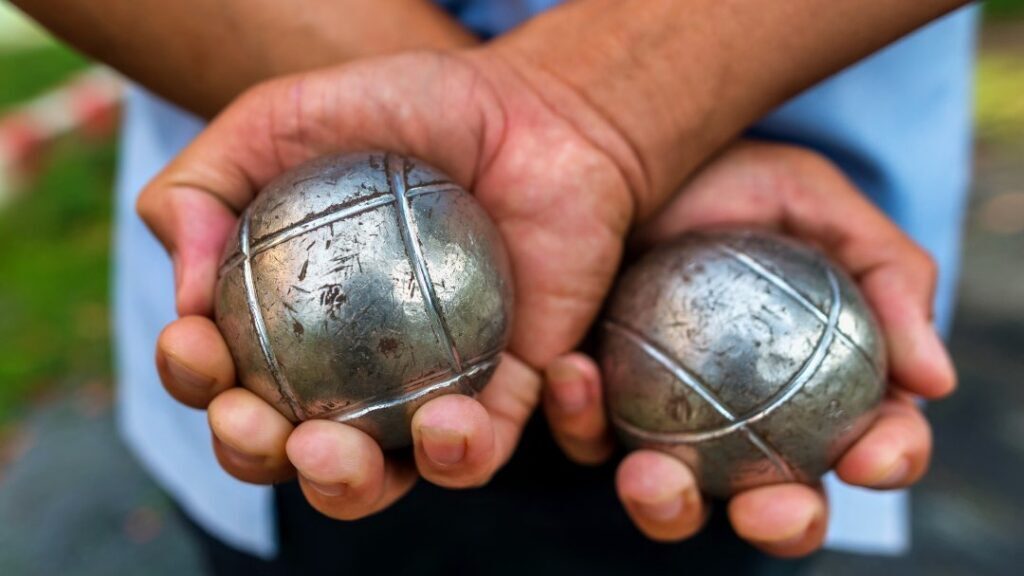
Pétanque – a game for everyone
In order to participate in a game of pétanque, you do not have to be born and raised in the Mediterranean, but you must be able to throw a heavy steel ball as close to a so-called “cochonnet” as possible, preferably hit it where it is located on the court.
It sounds like something nice and exotic, but it is simply a small block of wood whose distinguished name in French hides the word “pig” in English, but which is not subjected to greater violence than what hides in the thrower’s modest arm strength.
It is the pétanque ball that controls
The first time you lift up one of the balls which is used in the popular outdoor competition game, you wonder about its weight and sense of gravity. It is made of solid steel, weighs 650-800 g, and is clearly intended to be thrown over short, not long distances, on the court of gravel created for the purpose.

The word pétanque is derived from the Provencal dialect “ped tanca”, which means “to stand firmly on the ground”. It is the ball that must control you, not the body. The game is also called boule, which in reality is a common expression for the many variants of the game that exist, all of which are ancient and have always been very popular.
The throwing method also varies from game type to game type, often direct throwing is used, often, as in bowling, underhand throwing.
Without pastis no pétanque
In Provence, you like to grab a pastis before the game, the popular mix of anise seeds, licorice and sugar, and good food also belongs – after all, you only need one hand to send the ball off.
Also read:

The joy of all three activities starts in the spring, when the courts are swept clean and the players get ready for battle. Pétanque, which is the best known of the ball games, has long ago spread beyond not just Southern Europe, but also further north and east.
Many come home from tourist trips in the south of France and immediately embark on the new hobby. Whether the pastis follows, the story does not tell, but who will forsake good food and an aperitif of any sort as a game starter? Some might even come up with an improvement.
Pétanque “bigger” than FIFA?
It sounds incredible, but around the world there are 76 national pétanque associations, which have a total of 600,000 licensed players under their wings. Here, even football’s FIFA will have a hard time keeping up. Thus, the game has great use among amateurs, but also has a very serious attraction for professionals.
Remember the accent!
The hard core of French pétanque veterans dislike when the game in other countries’ spellings is written without the accent over the e in the first syllable, whereby the pronunciation should then falsely sound like a light “p” as in “private”, not a serious “p” as in “pee” as it should be: pp-hey-tank- a (like in “a” ball) = pétanque ! !!
But otherwise, as you know, success has many fathers. Italians, for example, play boccia and raffa, which are related boule games. In Spain, you play petanca, where you use a cane to hit the balls. Here, the oldest townspeople can also join in.
Where does pétanque come from?
As already mentioned, ball games with different kinds of ball sizes and game rules have been with us for a very long time. Egypt, for instance, has evidence of this that is older than the pyramids.
Pétanque, on the other hand, is a relatively new game. As late as 1907, a man suffering from arthritis, Jules Lenoir, from the town of La Ciotat near Marseille, changed the then existing game of jeu revenuecal so that the court length was shortened and the opening run-up was no longer to be used. This idea spread, and the ball game under the name pétanque was born. New wine on old bottles.
How is pétanque played?
According to the rules, the court which is laid out must be 4 x 15 meters and have a gravel layer of 20 cms thickness at the top. (However, you CAN also play on grass). Either you are 2 players with 3 balls each, or 3 players with 2 balls each. In other words, two teams playing against each other.
The team/player who wins the draw throws the “pig” onto the field at a proper distance. In turn, the players throw their balls in an attempt to get closest to the “pig”. Once all the balls have been thrown, points are awarded, but only to the winning team. Then you start a new round until one of the teams has achieved 13 points.
The video below explains the game so everyone can join in.
Playing on one of the world’s most famous courts in Saint-Paul de Vence.
Pétanque can be played by anybody who can throw a ball. Both high and low can join. And it is just as prestigious to participate if you are the butcher’s assistent or the baker’s youngest daughter as if you are one of the rich and famous.
At Place de Gaulle in Saint-Paul de Vence, considered by many to be the cultural and geographical center of the game, you can get a lesson in the rules and a time on the course area of the place via the tourist office, where they like to brag about all the celebrities who have rolled the heavy balls of the city. Long before the word celebrity became fashionable.
It is not necessary to buy pétanque equipment from France. You’ll find plenty of retailers around the world, and they’re easy to track down online. Ball craziness knows no boundaries.
By Peter Sejersen – 2022, updated by Tommy Sverre 2024




